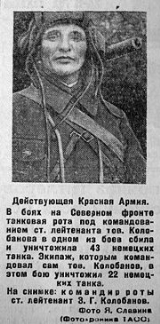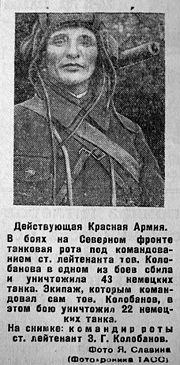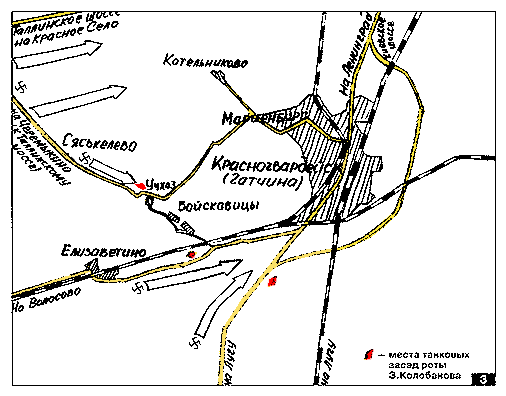
Zinoviy Kolobanov
Encyclopedia

Soviet Union
The Soviet Union , officially the Union of Soviet Socialist Republics , was a constitutionally socialist state that existed in Eurasia between 1922 and 1991....
.
Service
At the Battle of Krasnogvardeysk on 19 August 1941 (part of the Battle of Leningrad), Kolobanov's unit ambushed a column of German armour. The vanguard of the German 8th Panzer Division was approaching Krasnogvardeysk (GatchinaGatchina
Gatchina is a town and the administrative center of Gatchinsky District of Leningrad Oblast, Russia, located south of St. Petersburg by the road leading to Pskov...
) near Leningrad
Leningrad
Leningrad is the former name of Saint Petersburg, Russia.Leningrad may also refer to:- Places :* Leningrad Oblast, a federal subject of Russia, around Saint Petersburg* Leningrad, Tajikistan, capital of Muminobod district in Khatlon Province...
(now St Petersburg), and the only Soviet force available to stop it consisted of five well-hidden KV-1 tanks, dug in within a grove at the edge of a swamp. KV-1 tank no. 864 was commanded by the leader of this small force, Lieutenant
Lieutenant
A lieutenant is a junior commissioned officer in many nations' armed forces. Typically, the rank of lieutenant in naval usage, while still a junior officer rank, is senior to the army rank...
Kolobanov.
The German forces attacked Krasnogvardeysk from three directions. Near Noviy Uchkhoz settlement, the geography favoured the Soviet defenders as the only road in the region passed the swamp, and the defenders commanded this choke point from their hidden position. Lieutenant Kolobanov had carefully studied the situation and readied his detachment the day before. Each KV-1 tank carried twice the normal amount of ammunition, two-thirds of which were armour-piercing rounds. Kolobanov ordered his other commanders to hold their fire and await orders. He did not want to reveal the size of his force, so only one tank at a time engaged the enemy.
The 8th Panzer Division's vanguard entered directly into the well-prepared Soviet ambush. Kolobanov's tank knocked out the leading German tank with its first shot. The German column assumed that the tank had hit an anti-tank mine
Anti-tank mine
An anti-tank mine, , is a type of land mine designed to damage or destroy vehicles including tanks and armored fighting vehicles....
and, failng to realize that they were being ambushed, stopped. This gave Kolobanov the opportunity to destroy the second tank. The Germans realized they were under attack but were unable to locate the origin of the shots. While the German tanks fired blindly, Kolobanov knocked out the trailing German tank, boxing in the entire column.

Artillery
Originally applied to any group of infantry primarily armed with projectile weapons, artillery has over time become limited in meaning to refer only to those engines of war that operate by projection of munitions far beyond the range of effect of personal weapons...
pieces were knocked out by Kolobanov's tank before it ran out of ammunition. Kolobanov ordered in another KV-1, and 21 more German tanks were destroyed before the half-hour battle ended. A total of 43 German tanks had been destroyed by the five Soviet KV-1s (two more remained in reserve).
For their actions, Lieutenant Kolobanov was awarded the Order of the Red Banner
Order of the Red Banner
The Soviet government of Russia established the Order of the Red Banner , a military decoration, on September 16, 1918 during the Russian Civil War...
and his gunner, Andrei Usov, was awarded the Order of Lenin
Order of Lenin
The Order of Lenin , named after the leader of the Russian October Revolution, was the highest decoration bestowed by the Soviet Union...
.
The Soviet victory was the result of a well-planned ambush on advantageous ground and superiority of weapons. Most of the German tanks in this battle were Panzer II
Panzer II
The Panzer II was the common name for a family of German tanks used in World War II. The official German designation was Panzerkampfwagen II...
light tanks armed with only 20 mm guns, with a few Panzer III
Panzer III
Panzer III was the common name of a medium tank that was developed in the 1930s by Germany and was used extensively in World War II. The official German designation was Panzerkampfwagen III translating as "armoured battle vehicle". It was intended to fight other armoured fighting vehicles and...
medium tanks armed with 37 mm
3.7 cm KwK 36
The 3.7 cm KwK 36 L/45 was a German 3.7 cm cannon used primarily as the chief weapon of variants of the German medium tank the SdKfz.141 Panzerkampfwagen III...
guns. The German tank guns had neither the range nor the power of the 76 mm main gun of a KV-1. After the battle, the crew of No. 864 counted a total of 135 hits on their tank, none of which had penetrated the armor. The narrower tracks of the German tanks caused them to become trapped in the swampy ground.
Later on, former Captain Zinoviy Kolobanov was again decorated by Soviet authorities, despite having been convicted and downgraded after the Winter War
Winter War
The Winter War was a military conflict between the Soviet Union and Finland. It began with a Soviet offensive on 30 November 1939 – three months after the start of World War II and the Soviet invasion of Poland – and ended on 13 March 1940 with the Moscow Peace Treaty...
for "fraternizing with the enemy." After the end of World War II
World War II
World War II, or the Second World War , was a global conflict lasting from 1939 to 1945, involving most of the world's nations—including all of the great powers—eventually forming two opposing military alliances: the Allies and the Axis...
, Lieutenant Kolobanov served in the Soviet occupation zone in East Germany, where he was convicted again when a subordinate escaped to the British occupation zone, and was transferred to the reserves.
He remained in the army for some years, based in Belarus
Belarus
Belarus , officially the Republic of Belarus, is a landlocked country in Eastern Europe, bordered clockwise by Russia to the northeast, Ukraine to the south, Poland to the west, and Lithuania and Latvia to the northwest. Its capital is Minsk; other major cities include Brest, Grodno , Gomel ,...
, and retired as a Lieutenant-Colonel. He then went on to work for the Minsk Auto Works
Minsk Automobile Plant
Minsk Automobile Plant is a state-run automotive manufacturer association in Belarus, one of the largest in Eastern and Central Europe.-History:...
.
A monument dedicated to the battle was installed in the village of Noviy Uchkhoz in 1980, at the place where Kolobanov's KV-1 was dug in, due solely to the demands of the villagers. Unfortunately it was impossible to find a KV-1 tank, so an IS-2
Iosif Stalin tank
The Iosif Stalin tank , was a heavy tank developed by the Soviet Union during World War II and first used in the Kursk area in September 1943...
heavy tank was installed there instead.
On 8 September 2006, a monument in his honour was unveiled in Minsk
Minsk
- Ecological situation :The ecological situation is monitored by Republican Center of Radioactive and Environmental Control .During 2003–2008 the overall weight of contaminants increased from 186,000 to 247,400 tons. The change of gas as industrial fuel to mazut for financial reasons has worsened...
, the capital of Belarus
Belarus
Belarus , officially the Republic of Belarus, is a landlocked country in Eastern Europe, bordered clockwise by Russia to the northeast, Ukraine to the south, Poland to the west, and Lithuania and Latvia to the northwest. Its capital is Minsk; other major cities include Brest, Grodno , Gomel ,...
. It was sponsored by the director of AGAVA, Vasiliy Monich.

